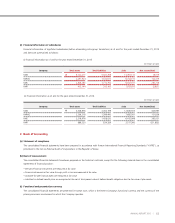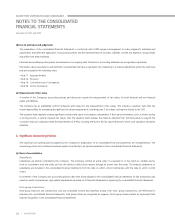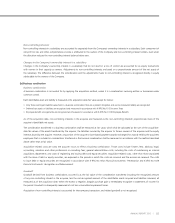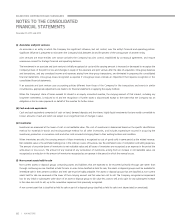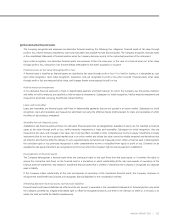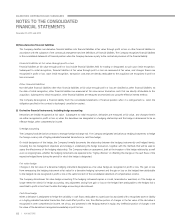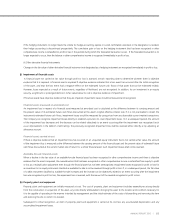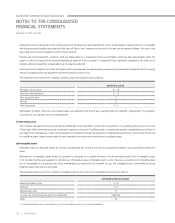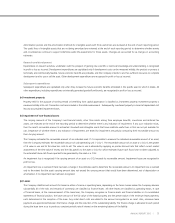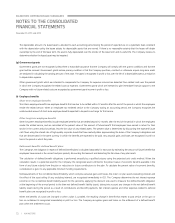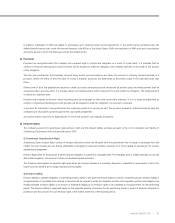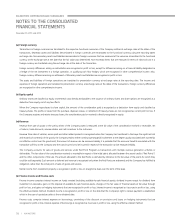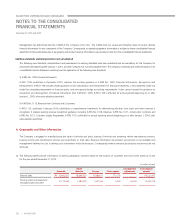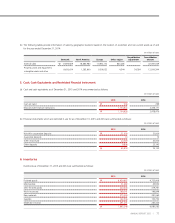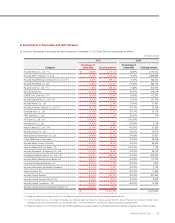Kia 2015 Annual Report Download - page 75
Download and view the complete annual report
Please find page 75 of the 2015 Kia annual report below. You can navigate through the pages in the report by either clicking on the pages listed below, or by using the keyword search tool below to find specific information within the annual report.
If the hedging instrument no longer meets the criteria for hedge accounting, expires or is sold, terminated, exercised, or the designation is revoked,
then hedge accounting is discontinued prospectively. The cumulative gain or loss on the hedging instrument that has been recognized in other
comprehensive income is reclassified to profit or loss in the periods during which the forecasted transaction occurs. If the forecasted transaction is no
longer expected to occur, then the balance in other comprehensive income is recognized immediately in profit or loss.
(ii) Other derivative financial instruments
Changes in the fair value of other derivative financial instrument not designated as a hedging instrument are recognized immediately in profit or loss.
(j) Impairment of financial assets
A financial asset not carried at fair value through profit or loss is assessed at each reporting date to determine whether there is objective
evidence that it is impaired. A financial asset is impaired if objective evidence indicates that a loss event has occurred after the initial recognition
of the asset, and that the loss event had a negative effect on the estimated future cash flows of that asset that can be estimated reliably.
However, losses expected as a result of future events, regardless of likelihood, are not recognized. In addition, for an investment in an equity
security, a significant or prolonged decline in its fair value below its cost is objective evidence of impairment.
If financial assets have objective evidence that they are impaired, impairment losses should be measured and recognized.
Financial assets measured at amortized cost
An impairment loss in respect of a financial asset measured at amortized cost is calculated as the difference between its carrying amount and
the present value of its estimated future cash flows discounted at the asset’s original effective interest rate. If it is not practicable to obtain the
instrument’s estimated future cash flows, impairment losses would be measured by using prices from any observable current market transactions.
The Company can recognize impairment losses directly or establish a provision to cover impairment losses. If, in a subsequent period, the amount
of the impairment loss decreases and the decrease can be related objectively to an event occurring after the impairment was recognized (such
as an improvement in the debtor’s credit rating), the previously recognized impairment loss shall be reversed either directly or by adjusting an
allowance account.
Financial assets carried at cost
If there is objective evidence that an impairment loss has occurred on an unquoted equity instrument that is not carried at fair value, the amount
of the impairment loss is measured as the difference between the carrying amount of the financial asset and the present value of estimated future
cash flows discounted at the current market rate of return for a similar financial asset. Such impairment losses shall not be reversed.
Available-for-sale financial assets
When a decline in the fair value of an available-for-sale financial asset has been recognized in other comprehensive income and there is objective
evidence that the asset is impaired, the cumulative loss that had been recognized in other comprehensive income is reclassified from equity to profit
or loss as a reclassification adjustment even though the financial asset has not been derecognized. Impairment losses recognized in profit or loss for
an investment in an equity instrument classified as available-for-sale is not be reversed through profit or loss. If, in a subsequent period, the fair value
of a debt instrument classified as available-for-sale increases and the increase can be objectively related to an event occurring after the impairment
loss was recognized in profit or loss, the impairment loss is reversed, with the amount of the reversal recognized in profit or loss.
(k) Property, plant and equipment
Property, plant and equipment are initially measured at cost. The cost of property, plant and equipment includes expenditures arising directly
from the construction or acquisition of the asset, any costs directly attributable to bringing the asset to the location and condition necessary for
it to be capable of operating in the manner intended by management and the initial estimate of the costs of dismantling and removing the item
and restoring the site on which it is located.
Subsequent to initial recognition, an item of property, plant and equipment is carried at its cost less any accumulated depreciation and any
accumulated impairment losses.
69
ANNUAL REPORT 2015 |






